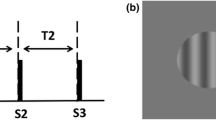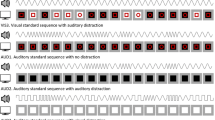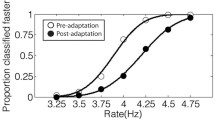Abstract
It has been argued that both modality-specific and supramodal mechanisms dedicated to time perception underlie the estimation of interval durations. While it is generally assumed that early sensory areas are dedicated to modality-specific time estimation, we hypothesized that early sensory areas such as the primary visual cortex or the auditory cortex might be involved in time perception independently of the sensory modality of the input. To test this possibility, we examined whether disruption of the primary visual cortex or the auditory cortex would disrupt time estimation of auditory stimuli and visual stimuli using transcranial magnetic stimulation (TMS). We found that disruption of the auditory cortex impaired not only time estimation of auditory stimuli but also impaired that of visual stimuli to the same degree. This finding suggests a supramodal role of the auditory cortex in time perception. On the other hand, TMS over the primary visual cortex impaired performance only in visual time discrimination. These asymmetric contributions of the auditory and visual cortices in time perception may be explained by a superiority of the auditory cortex in temporal processing. Here, we propose that time is primarily encoded in the auditory system and that visual inputs are automatically encoded into an auditory representation in time discrimination tasks.




Similar content being viewed by others
References
Alexander I, Cowey A, Walsh V (2005) The right parietal cortex and time perception: back to Critchley and the Zeitraffer phenomenon. Cogn Neuropsychol 22(3/4):306–315
Ayhan I, Bruno A, Nishida S, Johnston A (2009) The spatial tuning of adaptation-based time compression. J Vis 9(11):2 1–12
Bueti D, Walsh V (2009) The parietal cortex and the representation of time, space, number and other magnitudes. Phil Trans R Soc B Biol Sci 364:1831–1840
Bueti D, Bahrami B, Walsh V (2008a) The sensory and association cortex in time perception. J Cogn Neurosci 20:1–9
Bueti D, van Dongen EV, Walsh V (2008b) The role of superior temporal cortex in auditory timing. PLoS One 3:e2481
Burr D, Banks MS, Morrone MC (2009) Auditory dominance over vision in the perception of interval duration. Exp Brain Res 198:49–57
Chen K-M, Yeh S-L (2009) Asymmetric cross-modal effects in time perception. Acta Psychol 130:225–234
Coull JT, Vidal F, Nazarian B, Macar F (2004) Functional anatomy of the attentional modulation of time estimation. Science 303:1506–1508
Coull JT, Nazarian B, Vida F (2008) Timing, storage and comparison of stimulus duration engage discrete anatomical components of a perceptual timing network. J Cogn Neurosci 20:2185–2197
Ferrandez AM, Hugueville L, Lehericy S, Poline JB, Marsault C et al (2003) Basal ganglia and supplementary motor area subtend duration perception: an fMRI study. Neuroimage 19:1532–1544
Franssen V, Vandierendonck A, van Heil A (2006) Duration estimation and the phonological loop: articulatory suppression and irrelevant sounds. Psychol Res 70:304–316
Getzmann S (2007) The effect of brief auditory stimuli on visual apparent motion. Perception 36:1089–1103
Ghose GM, Maunsell JHR (2002) Attentional modulation in visual cortex depends on task timing. Nature 419:616–620
Goldstone S, Lhamon WT (1974) Studies of auditory-visual differences in human time judgment: 1. Sounds are judged longer than lights. Percept Mot Skills 39:63–82
Goldstone S, Boardman WK, Lhamon WT (1959) Intersensory comparisons of temporal judgments. J Exp Pscyhol 57:243–248
Grondin S (2010) Timing and time perception: a review of recent behavioral and neuroscience findings and theoretical directions. Atten Percept Psychophys 72:561–582
Grondin S, Roussel M-E, Gamache P-L, Roy M, Ouellet B (2005) The structure of sensory events and the accuracy of time judgments. Perception 34:45–58
Harrington DL et al (1998a) Temporal processing in the basal ganglia. Neuropsychology 12:3–12
Harrington DL et al (1998b) Cortical networks underlying mechanisms of time perception. J Neurosci 18:1085–1095
Hickok G, Buschsbaum B, Humphries C, Muftuler T (2003) Auditory-motor interaction revealed by fMRI: speech, music and working memory in area Spt. J Cogn Neurosci 15:673–682
Huang YZ, Edwards MJ, Rounis E, Bhatia KP, Rothwell JC (2005) Theta burst stimulation of the human motor cortex. Neuron 45:201–206
Ivry R, Keele S (1989) Timing functions of the cerebellum. J Cogn Neurosci 1:136–152
Ivry RB, Schlerf JE (2008) Dedicated and intrinsic models of time perception. Trends Cogn Sci 12:273–280
Ivry RB et al (2002) The cerebellum and event timing. Ann NY Acad Sci 978:302–317
Janssen P, Shadlen MN (2005) A representation of the hazard rate of elapsed time in macaque area LIP. Nat Neurosci 8:234–241
Johnston A, Arnold DH, Nishida S (2006) Spatially localised distortions of event time. Curr Biol 16:472–479
Kanai R, Paffen CLE, Hogendoorn H, Verstraten FAJ (2006) Time dilation in dynamic display. J Vis 6(12):8 1421–1430
Leon MI, Shadlen MN (2003) Representation of time by neurons in the posterior parietal cortex of the macaque. Neuron 38:317–327
Lewald J, Meister IG, Widemann J, Topper R (2004) Involvement of the superior temporal cortex and the occipital cortex in spatial hearing: evidence from repetitive transcranial magnetic stimulation. J Cogn Neurosci 16:828–838
Lewis PA, Miall RC (2006) A right hemispheric prefrontal system for cognitive time measurement. Behav Processes 71:226–234
Lhamon WT, Goldstone S (1974) Studies in auditory-visual differences in human time judgment: 2. More transmitted information with sounds than lights. Percept Mot Skills 39:295–307
Morein-Zamir S, Soto-Faraco S, Kingstone A (2003) Auditory capture of vision: examining temporal ventriloquism. Cogn Brain Res 17:154–163
Morosan P et al (2001) Human primary auditory cortex: cytoarchitectonic subdivisions and mapping into a spatial reference system. Neuroimage 13:669–683
Morrone MC (2005) Saccadic eye movements cause compression of time as well as space. Nat Neurosci 8:950–954
Pariyadath V, Eagleman DM (2008) Brief subjective durations contrast with repetition. J Vis 8(16):11 1–6
Penny TB, Gibbon J, Meck WH (2000) Differential effects of auditory and visual signals on clock speed and temporal memory. J Exp Psychol Hum Percept Perform 26:1770–1787
Rao SM et al (1997) Distributed neural systems underlying the timing of movements. J Neurosci 17:5528–5535
Rao SM et al (2001) The evolution of brain activation during temporal processing. Nat Neurosci 4:317–323
Shuler MG, Bear MF (2006) Reward timing the primary visual cortex. Science 311:1606–1609
Vallesi A, Shallice T, Walsh V (2007) Role of the prefrontal cortex in the foreperiod effect: TMS evidence for dual mechanisms in temporal preparation. Cereb Cortex 17:466–474
van Wassenhove V, Buonomano DV, Shimojo S, Shams L (2008) Distortions of subjective time perception within and across senses. PLoS ONE 3(1):e1437
Walker JT, Scott KJ (1981) Auditory-visual conflicts in the perceived duration of lights, tones and gaps. J Exp Psychol Hum Percept Perform 7:1327–1339
Wearden JH, Edwards H, Fakhri M, Percival A (1998) Why “sounds are judged longer than lights”: Application of a model of the internal clock in humans. Q J Exp Psychol 51B:97–120
Xuan B, Zhan D, He S, Chen X (2007) Larger stimuli are judged to last longer. J Vis 7(10):1–5
Yarrow K, Haggard P, Heal R, Brown P, Rothwell JC (2001) Illusory perceptions of space and time preserve cross-saccadic perceptual continuity. Nature 414:302–305
Zimmer U, Lewald J, Erb M, Grodd W, Karnath HO (2004) Is there a role of visual cortex in spatial hearing? Eur J Neurosci 20:3148–3156
Acknowledgments
This work was supported by Human Frontier Science Foundation for RK, Nuffield Bursary for HL and the U.K. medical council (G0700929) for VW.
Author information
Authors and Affiliations
Corresponding author
Rights and permissions
About this article
Cite this article
Kanai, R., Lloyd, H., Bueti, D. et al. Modality-independent role of the primary auditory cortex in time estimation. Exp Brain Res 209, 465–471 (2011). https://doi.org/10.1007/s00221-011-2577-3
Received:
Accepted:
Published:
Issue Date:
DOI: https://doi.org/10.1007/s00221-011-2577-3




